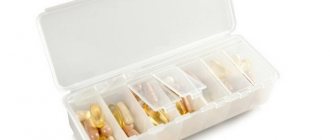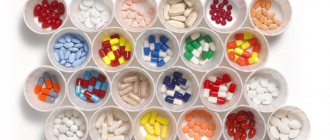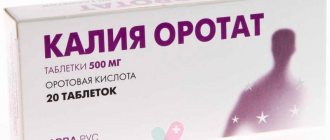The value of potassium for humans
This microelement is responsible for the condition and performance of many systems and organs of the body. It regulates the functioning of muscle fibers, blood vessels and heart muscle, stabilizes the processing of sugar into energy, normalizes the level of electrolytes in the blood and stimulates the functioning of the nervous system.
In addition, potassium provides protection for the body from the negative effects of sodium ions.
The role of potassium in the human body
The main task of the microelement is to alkalize the blood. This cation is also responsible for the level of magnesium in the blood serum.
It normalizes the conductivity of nerve fibers, helping to eliminate depressive disorders, and stabilizes brain function, increasing oxygen access to this organ.
Stable functioning of the cardiovascular system is another function for which the body needs potassium. Without the potassium element, the heart will contract incorrectly, so it will not be able to provide normal blood circulation.
To eliminate allergic manifestations, medical experts recommend using drugs and products that contain a lot of potassium.
The potassium trace element also has a positive effect on organs, including the liver, kidneys, cells, etc. Its deficiency negatively affects the health of teeth, bone tissue, hair and nail plates.
In addition, the role of potassium is that it ensures the removal of excess fluid from the body, minimizes the negative effects of toxins on organs and normalizes the synthesis of many enzymes.
Some potassium salts (including bromides and iodides) are used to treat constipation and improve kidney function.
The role of potassium in the human body
The human body needs potassium to perform the following functions:
- it is involved in the processes of converting glucose into glycogen and protein synthesis;
- is a regulator of the acid-base balance of the blood, osmotic pressure, water balance of intercellular and intracellular fluid, water-salt balance of the body;
- participates in the processes of transmission of nerve impulses;
- promotes normal intestinal activity and improves excretory function of the kidneys;
- is a necessary element for certain enzymes, and also promotes the metabolism of proteins and carbons in the body;
- normalizes blood pressure levels;
- participates in the nervous regulation of cardiac muscle contractions.
How much potassium should you consume daily?
The daily intake of drugs and products with potassium depends on age. For minors, the dosage is calculated at 15-30 mg per 1 kg of body weight. For adults, the minimum daily dosage is 1000 mg, the optimal is 2000 mg.
For the period of training in order to increase muscle mass, the consumption rate must be increased to 4000-5000 mg/day. For this purpose, a special diet or medications are used.
Potassium deficiency
If there is insufficient potassium in the body, the condition is called hypokalemia.
Main reasons
The main reasons for the development of element deficiency:
- too intensive removal from the body along with water;
- following dietary patterns too often;
- improper diet;
- excessive consumption of tea, soda and coffee;
- sodium concentration too high;
- increased levels of cesium, thallium and rubilium ions;
- the use of herbal remedies and medications that have a diuretic effect;
- hormone therapy;
- regular stress;
- diseases.
Symptoms of deficiency
With a microelement deficiency, the following negative manifestations are noted:
- convulsions;
- muscle weakness;
- constipation;
- swelling;
- weakened immunity;
- arrhythmia;
- state of apathy and feeling of drowsiness;
- deterioration of the functioning of the gastrointestinal tract;
- decrease in the amount of urine excreted;
- metabolic disease;
- baldness;
- nausea and/or vomiting;
- pressure surges;
- the formation of bruises in different parts of the body;
- dry skin;
- heart problems;
- breathing problems;
- increased fragility of nail plates;
- increased nervousness;
- deterioration during pregnancy;
- ulcerative lesions of the gastrointestinal mucosa.
Consequences
If hypokalemia is untreated, an erosive form of gastritis, erosion of the uterine cervix and stroke may develop. In severe cases, there is a high risk of death due to a heart attack.
To compensate for the lack of substance, the doctor prescribes a special diet and vitamin complexes. Negative manifestations require symptomatic therapy.
Indications for testing potassium levels
Potassium functions as an immunomodulator, resists hypoxia, and lowers blood pressure. A deficiency of a microelement provokes a malfunction of almost all internal organs; an excess leads to cardiac arrest.
A potassium test is necessary for all patients with diseases of the cardiovascular system, when taking antitumor or anti-inflammatory drugs. Indications for taking a test for potassium in the blood are: kidney pathologies of various origins, adrenal insufficiency, hypertension, arrhythmia. Monitoring the level of microelement is mandatory when undergoing hemodialysis, treatment with cardiac glycosides and diuretics.
Excess potassium
Excess potassium in the body (hyperkalemia) poses the same threat as its lack. If the concentration of this trace element is exceeded, dangerous pathologies may develop in the body, which require immediate medical intervention.
Main reasons
The most common causes of hyperkalemia:
- unbalanced diet;
- prolonged use of potassium-containing drugs;
- improper functioning of the kidneys;
- problems with potassium metabolism;
- disruptions in the functioning of the endocrine system;
- cytolysis and hemodialysis procedures;
- changes in serum sodium and magnesium levels;
- dysfunction of the sympathoadrenal system;
- problems with the urinary system.
Symptoms of excess
Hyperkalemia may be accompanied by the following negative signs:
- impaired mobility and sensitivity of the fingers of the lower and upper extremities;
- hyperactivity;
- muscle degradation;
- colic in the intestines;
- feeling of thirst;
- profuse sweating;
- frequent urination;
- formation of kidney stones;
- pale skin;
- intestinal disorders;
- sense of anxiety;
- skeletal muscle paralysis;
- muscle degradation.
Consequences
In severe cases, hyperkalemia can cause the development of anemia, paralysis and tissue necrosis. In this case, there is a possibility of death. If any adverse side effects occur, you should consult your doctor.
Why the body needs potassium: daily requirement
Hello, dear friends! Have you ever wondered why the body needs potassium? While we are healthy, we don’t want to delve too deeply into such subtleties. And in vain! Due to ignorance, we often harm our own health.
What you need to know about potassium!
Potassium, along with calcium, magnesium and sodium, is vital for the human body. Without this macroelement, the full functioning of the cardiovascular, nervous, musculoskeletal and excretory systems is impossible.
98% of the macroelement is contained in the cells of the body, and only 2% in the extracellular space. In cells its concentration is 30 times higher than in blood plasma.
His role is great:
- participates in the process of energy formation,
- regulates intracellular metabolism,
- participates in the synthesis of proteins and carbohydrates.
Why does the body need potassium?
- Maintains normal magnesium concentration. Both elements stabilize the functioning of the cardiovascular system. Strengthens the heart muscles. Makes the walls of blood vessels elastic.
- Stabilizes blood pressure.
- In interaction with sodium, it ensures the conduction of nerve impulses in the body.
- Supply the brain with oxygen and glucose. Due to this, it improves a person’s memory, ensures concentration and clarity of thinking.
- Helps preserve calcium in the body. Prevents osteoporosis.
- Reduces the amount of extracted calcium in the urine. Due to this, it prevents the formation of kidney stones.
- Regulates intracellular exchange of water and salts. Removes excess fluid and salts from the body.
- Helps maintain a normal acid-base environment.
Daily norm
The recommended daily intake of potassium for adults is from 1800 to 5000 milligrams, for children - from 600 to 1700. To accurately calculate the required daily intake, body weight, physical activity, physiological condition, and even the climate of the place of residence are taken into account.
The average norm by age category looks like this:
| Category | Daily norm |
| children under 2 years old | 400-600 mg; |
| children from 3 to 5 years old | 3000 mg; |
| children from 6 to 8 years old | 3800 mg; |
| children from 9 to 13 years old | 4500 mg; |
| teenagers under 18 years old | 4600 mg. |
| women – 4700 mg; | 4700 mg; |
| women during pregnancy and lactation | 5100 mg; |
| men | 4800 mg; |
The presence of potassium in the body is an unstable and rapidly changing indicator. Often the cause of this is our own wrong actions.
The body does not store potassium. Therefore, there is only as much of it in him as he can absorb at a given moment.
Therefore, even a slight deficiency of this element leads to a malfunction in the body. And it occurs in a matter of hours - as soon as the normal balance between potassium and sodium is disrupted. A deficiency of a macronutrient, like an excess, is dangerous to human health and life. It can lead not only to serious illnesses. To a quick death.
What is hypokalemia?
Lack of potassium in the body – hypokalemia.
Causes disruption of cardiac and skeletal muscles. Long-term potassium deficiency can cause acute neuralgia. And in severe cases – the death of the patient.
Signs of hypokalemia
- A feeling of fatigue that persists even after sleep and rest.
- Fast fatiguability.
- Sleep disturbance.
- Sense of anxiety.
- Depression.
- Fluctuating blood pressure.
- Heart rhythm disturbance.
- In such conditions, sometimes it is enough to replenish the potassium content in the body and the person’s condition will improve.
Causes of hypokalemia
- Disease of the kidneys and adrenal glands.
- Diabetes.
- Stress.
- Poor nutrition.
- Great physical activity.
Often the cause of a lack of potassium in the body is bad habits and rash actions of the person himself.
- Alcohol abuse. Drinking more than 30 ml of hard liquor daily.
- Passion for sweets. The daily total dose of sugar intake for men should not be more than 60 g, for women - 50 g.
- Using diuretics and laxatives for weight loss
- Using diuretics to relieve swelling.
Why can’t you take laxatives without medical indications?
With diarrhea, a person loses more than just water. Huge amount of potassium. Within a few hours, a person may die not from dehydration, but from hypokalemia. That is why patients are injected with saline solutions containing a lot of potassium.
Why can’t you take diuretics without medical indications?
- You need to know that diuretics are never used to relieve local edema. If a person's legs are swollen, this is not a reason to take medicine. Swelling of the legs is the price to pay for walking upright. When a person spends a lot of time on his feet, blood begins to stagnate in the veins, sweats and leaves the vascular bed. Normally, any person, if he does not lie on the bed, gains from 500 grams to a kilogram in the evening.
- Young people, especially girls, often use diuretics to lose weight. Removing water from the body and losing extra pounds are different processes. Taking diuretics gives misleading results. Stepping on the scale, a person discovers that he has lost a couple of kilograms. But this is a temporary effect. It is achieved not as a result of reduction of adipose tissue, but as a result of dehydration of the body.
In both cases, the body reacts equally to the administration of diuretics.
It takes measures to restore it - it produces a hormone that does not allow the fluid to leave. The problem is that potassium leaves the body along with urine and loose stools.
Diuretics do not remove water from the body. They remove sodium. And liquid follows sodium. Potassium is directly bound to sodium and exits after it.
Why can diuretics be taken to treat hypertension?
Drugs used to treat hypertension include the diuretic hydrochlorothiazide. Treatment of hypertension without it is impossible. If, in order to treat hypertension, drugs are taken in the same dose at the same time, potassium loss will occur only in the first three weeks. Then the situation stabilizes.
What to do if you have low potassium?
- First of all, you need to find out the reason.
- Pass a medical examination. Check your kidneys.
- Stop taking diuretics unless medically indicated.
- If potassium is low, but diuretics need to be taken due to a health condition, simultaneously take medications that retain potassium in the body.
- Reconsider your eating habits.
Make your diet correctly. Include foods rich in macronutrients.
Products rich in K
| The product's name | in 100g | Percentage of Daily Value |
| Apricot | 305 mg | 12% |
| Avocado | 485 mg | 19% |
| Peanut | 658 mg | 26% |
| Banana | 348 mg | 14% |
| White mushrooms | 468 mg | 19% |
| Cowberry | 90 mg | 4% |
| Melon | 118 mg | 5% |
| Walnuts | 474 mg | 19% |
| Buckwheat (kernel) | 380 mg | 15% |
| Blackberry | 208 mg | 8% |
| Strawberries | 161 mg | 6% |
| Raisin | 830 mg | 33% |
| Ginger | 415 mg | 17% |
| White cabbage | 300 mg | 12% |
| Brussels sprouts | 375 mg | 15% |
| Kohlrabi cabbage | 370 mg | 15% |
| Squid | 280 mg | 11% |
| Potato | 568 mg | 23% |
| Pine nuts | 597 mg | 24% |
| Kiwi | 300 mg | 12% |
| Cilantro | 521 mg | 21% |
| Watercress | 606 mg | 24% |
| Gooseberry | 260 mg | 10% |
| Sesame | 497 mg | 20% |
| Dried apricots | 1717 mg | 69% |
| Green onion | 259 mg | 10% |
| Almond | 748 mg | 30% |
| Mussels | 310 mg | 12% |
| Pollock | 420 mg | 17% |
| Sea kale | 970 mg | 39% |
| Oat groats | 362 mg | 14% |
| Honey mushrooms | 400 mg | 16% |
| Oat bran | 566 mg | 23% |
| Wheat bran | 1260 mg | 50% |
| Fresh parsley | 800 mg | 32% |
| Peach | 363 mg | 15% |
| Dried peach | 2043 mg | 82% |
| Beef liver | 277 mg | 11% |
| Tomato | 290 mg | 12% |
| Radish | 255 mg | 10% |
| Black radish | 357 mg | 14% |
| Beet | 288 mg | 12% |
| Salmon | 420 mg | 17% |
| Sunflower seeds | 647 mg | 26% |
| Red currants | 275 mg | 11% |
| Black currant | 350 mg | 14% |
| Dill | 335 mg | 13% |
| Dried apricots | 1781 mg | 71% |
| Grain beans | 1100 mg | 44% |
| Green beans | 260 mg | 10% |
| Dates | 370 mg | 15% |
| Pistachios | 1025 mg | 41% |
| Hazelnut | 445 mg | 18% |
| Sunflower halva | 351 mg | 14% |
| Prunes | 864 mg | 35% |
| Garlic | 260 mg | 10% |
| Sorrel | 500 mg | 20% |
| Champignon | 530 mg | 21% |
| Bitter chocolate | 363 mg | 15% |
| Milk chocolate | 462 mg | 18% |
| Spinach | 774 mg | 31% |
| Apples | 278 mg | 11% |
Medical studies have proven that increasing daily potassium intake by just 10 mmol reduces the risk of stroke by 40%.
What is hyperkalemia?
If you take drugs that retain potassium, take antibiotics with the same function, or eat foods rich in microelements, you may get the opposite result. There may be a lot of potassium. High levels of potassium in the body are just as dangerous as low ones.
Excess potassium in the body – hyperkalemia.
Signs of hyperkalemia
- General weakness.
- Increased fatigue.
- At an early stage, changes in the ECG.
- Stomach cramps.
- An arrhythmia that, without treatment, leads to death in 40% of cases.
- Spontaneous vomiting.
- Small intestinal ulcer.
- Decreased urge to urinate, accompanied by a decrease in the amount of urine excreted.
- Periodic confusion.
- Muscle cramps.
- Change in sensitivity. The appearance of a tingling sensation in the limbs.
- Difficulty breathing.
- Progressive ascending paralysis.
What to do?
At the first suspicion of hyperkalemia, you should consult a doctor. Remember! They are taken out of this state in hospitals. In severe cases, resuscitation and intensive care are required.
So we found out why the body needs potassium. Take care of yourself and be healthy!
I suggest watching a useful video on the topic.
Subscribe to blog updates! You don't want to miss new materials, do you?
Source: https://ydachari.ru/health/dlja-chego-organizmu-nuzen-kalii.html
Potassium standards for different categories and ages
The optimal level of this substance is individual for each individual case, depending on the person’s age, daily routine, health status and diet.
Most of this substance is required by professional athletes and people whose bodies are deficient in it. In this case, it is used in dosages up to 5000 mg/day. To compensate for the level of microelement, special preparations with potassium can be used.
Adults need to consume from 1500 to 2000 mg of microelement per day. Nursing and pregnant women need an increased daily dosage (from 3300 to 3500 mg).
For adolescent patients, the dosage is calculated based on weight - 20 mg is needed per 1 kg of body weight.
An increased content of potassium in the daily diet is also required for people who use medications that accelerate its elimination from the body, are engaged in heavy physical work, or are exposed to significant stress. In such situations, you should consult a doctor, who will determine the daily requirement of potassium in grams and give additional recommendations on maintaining the optimal concentration of this trace element in the body.
What is the normal level of potassium in the blood of a woman, man and child?
In children, the microelement norm in the blood is as follows:
- under 1 year – from 4 to 5.4 mmol/l;
- from 1 to 15 years – from 3.2 to 4.8 mmol/l;
- from 15 to 18 years – from 3.3 to 4.8 mmol/l.
The amount of substance depending on age and gender:
- from 18 to 40 years: for women – from 3.4 to 5.6 mmol/l, for men – from 3.4 to 5.6 mmol/l;
- over 40 years old: for women – from 3.3 to 4.8 mmol/l, for men – from 3.8 to 4.6 mmol/l;
- over 50 years of age: for women – from 3 to 4.5 mmol/l, for men – from 4 to 5.3 mmol/l.
Experts were able to prove that during the period of gestation, the concentration of the potassium microelement in the female body changes depending on the period, and after childbirth it decreases significantly, which is due to heavy blood loss.
In addition, women over 50 years of age need to monitor the concentration of this substance with particular care. The critical age for men is from 60 years.
Products rich in K
| The product's name | Contents per 100g | Percentage of Daily Value |
| Apricot | 305 mg | 12% |
| Avocado | 485 mg | 19% |
| Peanut | 658 mg | 26% |
| Banana | 348 mg | 14% |
| White mushrooms | 468 mg | 19% |
| Cowberry | 90 mg | 4% |
| Melon | 118 mg | 5% |
| Walnuts | 474 mg | 19% |
| Buckwheat (kernel) | 380 mg | 15% |
| Blackberry | 208 mg | 8% |
| Strawberries | 161 mg | 6% |
| Raisin | 830 mg | 33% |
| Ginger | 415 mg | 17% |
| White cabbage | 300 mg | 12% |
| Brussels sprouts | 375 mg | 15% |
| Kohlrabi cabbage | 370 mg | 15% |
| Squid | 280 mg | 11% |
| Potato | 568 mg | 23% |
| Pine nuts | 597 mg | 24% |
| Kiwi | 300 mg | 12% |
| Cilantro | 521 mg | 21% |
| Watercress | 606 mg | 24% |
| Gooseberry | 260 mg | 10% |
| Sesame | 497 mg | 20% |
| Dried apricots | 1717 mg | 69% |
| Green onion | 259 mg | 10% |
| Almond | 748 mg | 30% |
| Mussels | 310 mg | 12% |
| Pollock | 420 mg | 17% |
| Sea kale | 970 mg | 39% |
| Oat groats | 362 mg | 14% |
| Honey mushrooms | 400 mg | 16% |
| Oat bran | 566 mg | 23% |
| Wheat bran | 1260 mg | 50% |
| Fresh parsley | 800 mg | 32% |
| Peach | 363 mg | 15% |
| Dried peach | 2043 mg | 82% |
| Beef liver | 277 mg | 11% |
| Tomato | 290 mg | 12% |
| Radish | 255 mg | 10% |
| Black radish | 357 mg | 14% |
| Beet | 288 mg | 12% |
| Salmon | 420 mg | 17% |
| Sunflower seeds | 647 mg | 26% |
| Red currants | 275 mg | 11% |
| Black currant | 350 mg | 14% |
| Dill | 335 mg | 13% |
| Dried apricots | 1781 mg | 71% |
| Grain beans | 1100 mg | 44% |
| Green beans | 260 mg | 10% |
| Dates | 370 mg | 15% |
| Pistachios | 1025 mg | 41% |
| Hazelnut | 445 mg | 18% |
| Sunflower halva | 351 mg | 14% |
| Prunes | 864 mg | 35% |
| Garlic | 260 mg | 10% |
| Sorrel | 500 mg | 20% |
| Champignon | 530 mg | 21% |
| Bitter chocolate | 363 mg | 15% |
| Milk chocolate | 462 mg | 18% |
| Spinach | 774 mg | 31% |
| Apples | 278 mg | 11% |
Medical studies have proven that increasing daily potassium intake by just 10 mmol reduces the risk of stroke by 40%.
Presence of potassium in medications
Pharmacies now sell special potassium-containing drugs.
Most often they are prescribed:
- in case of disruption of the cardiovascular system;
- hypoglycemia;
- micronutrient deficiency;
- drug intoxication.
Such drugs are not prescribed for disorders of the urinary system and adrenal insufficiency.
The most popular drugs containing potassium are:
- Pentovit;
- Complivit;
- Alphabet;
- Vitrus.
Experts recommend using these drugs in courses of 30 days.
In addition, Asparkam and Panagin can be prescribed to compensate for the lack of microelements. These drugs contain not only a lot of potassium, but also magnesium. They are often prescribed for angina or after a heart attack.
In cases of severe hypokalemia, agents based on microelement chloride and acetate are prescribed.
Testing potassium levels in urine
For some diseases, a test is prescribed to determine the potassium content in the urine:
- to estimate the loss of substance per day;
- to identify water-electrolyte imbalances;
- to analyze renal and non-renal causes of micronutrient loss;
- to control the functioning of the adrenal cortex and kidneys.
The study may be ordered:
- to assess the effectiveness of therapy with potassium preparations in intensive care patients;
- when examining patients with dehydration, acidosis, alkalosis;
- with renal failure;
- for diseases of the adrenal glands;
- when using drugs that affect the microelement content;
- with hypo- or hyperkalemia.
IMPORTANT . Normal reference values should correspond to the following indicators: 25 - 125 mmol/day.
Potassium compatibility with other elements and digestibility
The trace element is absorbed from the gastrointestinal tract. It is eliminated from the body by the kidneys.
The substance does not concentrate in the body in the absence of health problems. The microelement coming from food is absorbed by 93-95%. Too frequent consumption of tea, coffee and alcohol can have a negative effect on the absorption of microelements.
Potassium and magnesium also influence each other. With increased magnesium concentration, sodium concentration decreases. With a deficiency of the magnesium element, the potassium substance begins to be absorbed less efficiently.
The relationship between potassium and sodium
There must be a balance between the level of this trace element and sodium, otherwise the substances will not perform their functions. If this ratio is violated, convulsive conditions and disturbances in the functioning of the nervous system may occur. If the balance between the potassium element and magnesium is disturbed, the functioning of the nervous system and heart muscle is disrupted.
Overdose safety rules
Potassium overdose can be caused by certain birth control pills, ACE inhibitors, or nonsteroidal anti-inflammatory drugs. The most common cause of overdose is kidney failure. Because the kidneys excrete potassium from the body, any deterioration in normal kidney function causes potassium levels to rise.
Excessive amounts of potassium supplements should be avoided. Potassium-sparing diuretics or salt substitutes also cause hyperkalemia. Identifying the cause of hyperkalemia is critical to choosing the appropriate treatment route.
Symptoms
Overdose symptoms include:
- lowering blood pressure;
- cramps in the stomach;
- diarrhea;
- nausea and vomiting;
- irritability and fatigue.
When the content of the element in the heart cells is disrupted, cardiac arrhythmias occur, which leads to neuromuscular failure. Some people report tingling in their fingers, toes, and tongue. In severe cases, hyperkalemia leads to respiratory failure or flaccid paralysis of the arms and legs. If treatment is not started promptly, the excess will have long-term effects on arterial and venous blood pressure, heart rhythm, gastrointestinal tract and renal function.
Treatment
The main goals of treating hyperkalemia include normalizing heart rate and stimulating the elimination of the element from the blood. Calcium gluconate, sodium bicarbonate, diuretics, sorbitol, or insulin are often administered. The action of these drugs is aimed at moving potassium ions from the blood back into cells or accelerating their release.
Which foods contain the most potassium?
The human body is not able to synthesize microelements on its own, so they must come from outside.
There are a large number of potassium-containing products, both animal and plant origin.
Products containing potassium. Table
| Product | Microelement content (in mg per 100 g) |
| Dutch cheese, rice cereal | 100 |
| wheat cereal, apple juice | 120 |
| chicken eggs and natural milk | 140 |
| pearl barley | 172 |
| carrots, orange | 200 |
| natural yogurt, garlic, onion | 260 |
| oatmeal, peaches | 362 |
| cabbage | 370 |
| buckwheat | 380 |
| bananas | 400 |
| avocado, porcini mushrooms | 450 |
| boiled potatoes | 630 |
| sunflower seeds and peas | 710 |
| peanuts and parsley | 760 |
| pine nuts, almonds | 780 |
| raisin | 1020 |
| raisin grapes | 1060 |
| wheat bran | 1160 |
| coffee beans and cocoa | 1600 |
| dried apricots | 2480 |
| tea | 2480 |
Potassium and food products
In order for the body to function well, it is enough to correctly create a weekly menu. Some food products need to be divided according to content and beneficial properties. This is important because some microelements can remove other useful minerals. There are people who don't eat meat at all, so they need to focus on eating plant foods while also taking sodium supplements. An ordinary person should consume foods of both plant and animal origin in a balanced manner, then all elements will be evenly supplied to the body.
Foods rich in potassium
In fact, food of animal origin is especially useful, because it saturates the body with both sodium and potassium at the same time. But vegetables actively remove sodium and impair the absorption of potassium.
How does a deficiency of B vitamins manifest: symptoms and treatment
Herbal Products Scheme:
- carrots (129 milligrams potassium)
- potatoes (429 milligrams)
- beetroot (155 mg)
- cabbage (148 mg)
- bread (240 milligrams)
- soy (1796 mg)
The following products are also recommended: melon, bananas, avocados, apricots and dried fruits, meat and dairy products and fish dishes. Normally, potassium is absorbed by the body up to ninety-five percent.
The list is topped by green tea, dried apricots and cocoa, since they contain the largest amount of the element. There are 2.6 grams of potassium per hundred grams of product. Next in terms of potassium content are milk and cheese.
Food should not be soaked in water or steamed during cooking, as all the potassium will remain in the liquid rather than in the food. If possible, it is best to eat the product fresh.
Tips for proper cooking
The benefits of any dish depend on its acidity, cooking temperature and oxygen supply. With prolonged thermal exposure, the structure of vitamins and microelements, including potassium, is destroyed.
To ensure that the prepared products are as healthy as possible, you must follow the following recommendations:
- food must be cooked at a temperature not exceeding +100°C;
- It is advisable to use a multicooker for cooking;
- The microwave oven should be used as little as possible;
- limit the amount of vegetable oil consumed.
In addition, nutritionists recommend avoiding or minimizing the amount of fatty foods consumed.
Potassium mixture. Recipe
To provide the body with potassium, you can use a mixture prepared from dried fruits. It contains the following ingredients:
- walnuts (0.2 kg);
- honey;
- lemon;
- prunes (0.2 kg);
- raisins (0.2 kg);
- dried apricots (0.2 kg).
The components of the cocktail are thoroughly mixed with each other, washed and steamed. You can use a meat grinder to grind them.
The finished mixture can be stored in the refrigerator in an airtight container. You need to consume the cocktail 1 tbsp. l. three times a day after meals. For minors, 1 dose/day is enough.
Nuts and dried fruits contain large amounts of this microelement, which normalizes the functions of the heart muscle. These products may be beneficial in the treatment of hypertension and atherosclerosis. Prune berries have a tonic effect and are often used to prevent cancer. Dried apricots improve visual function and the condition of blood vessels. Honey is one of the universal medicines.
Vitamin preparations containing potassium
To prevent or eliminate hypokalemia, special vitamin preparations can be used. The most popular of them:
- Vitrum centuria. Combined action agent. It contains all the substances that people over 50 need. Available in the form of tablets of 80 mg of the active ingredient (potassium).
- Dopelhertz Active. This drug compensates for the lack of vitamins and microelements in the body, improves mood and performance. The daily dosage of the product contains 600 mg of the potassium microelement. The manufacturer positions this product as an auxiliary source of biological substances.
- Teravit anti-stress. A complex multivitamin that contains extracts of some medicinal herbs and a large number of microelements. The drug is affordable. 1 granule contains 80 mg of potassium.
- Vitrum plus. Most often used during the period of rehabilitation after infections and viral pathologies, as well as during intense physical and intellectual stress.
- Panangin. The drug has moderate antiarrhythmic activity and normalizes metabolism.
- Asparkam. Contains a lot of magnesium. Normalizes metabolism and electrolyte balance.
- Potassium chloride. The product is available in glass ampoules. 1 ml of medicinal solution contains 40 mg of potassium microelement. The drug is prescribed for microelement deficiency and arrhythmia.
- Kudesan. 1 tablet of the product contains 0.097 g of potassium microelement. The drug is used in the treatment of diseases of the blood vessels and heart, as well as to reduce high blood pressure.
- Basiko concentrate. This product is a dietary supplement and is intended to stabilize the balance of a number of microelements. The concentrate is used for bone fractures, cardiovascular diseases, dermatological pathologies, gastric ulcers, urolithiasis and a number of other diseases.
- Centrum. A complex action product that contains many minerals and vitamins. Most often used to prevent hypovitaminosis, after long-term illnesses, treatment with antibiotic medications and with an unbalanced diet.
- Aspacard. Each tablet contains 36 mg of pure microelement. The drug prevents the development of arrhythmia.
- Vitalux plus. The biologically active food supplement is recommended for use in cases of retinal dystrophy and ophthalmological pathologies. Can be used as an auxiliary source of microelements.
- Orocamag. This drug is often included in the complex treatment of extrasystole and angina. Each tablet contains 125 mg of potassium trace element in the form of orotate and also the same amount of magnesium orotate.
- Pamaton. A product that contains magnesium. Available in the form of tablets or solution. It is used to prevent diseases of the cardiovascular system and compensate for the deficiency of vitamins and microelements in the body.
- Asparginate. Produced in the form of an infusion solution. The product normalizes blood flow, dilates arteries and improves cell permeability for microelements.
History - brief information
Potassium got its name from the Arabic word “al-kali” (القَلْيَه).
In the 11th century, one form of K (potassium carbonate), or "potash", was used as a detergent. It was extracted from the ash formed by burning wood and straw. Then it was treated with water to obtain a lye, filtered and evaporated. The dry residue, in addition to carbonate, contained soda, chloride (KCl) and potassium sulfate (K2SO4). Such production was known in the 17th century, which is why Peter I, in order to save forests, prohibited the use of forests for burning under pain of eternal exile. At the same time, old wood, knots and other secondary raw materials were burned to make potash.
Pure potassium in the form of a metal was first isolated by the English chemist Humphry Davy, who did this by electrolysis on a mercury cathode of wet potassium hydroxide (KOH). At the same time, the scientist obtained an amalgam of potassium, purifying it from mercury and obtaining pure metal K. Sir G. Davy named the resulting substance “Potasium” (lat. Potasium), still used in English, Spanish, French and other European languages. This work was described in the Baker Lecture, published on November 19, 1807. By the way, it was G. Davy who obtained other chemical elements in metallic form - magnesium, calcium, sodium, barium, lithium and strontium. About a year later, in 1808, the isolation of K by calcination of KOH with coal was achieved by other scientists - L. Tenard and Gay-Lussac. The modern name “Potassium” (Latin Kalium, K) was proposed to be used by L.V. Gilbert in 1809, which came into use first in the German language, and then migrated to the countries of North-Eastern Europe, and, as we see, won among the majority of scientists.
Read also: How to remove belly fat at home
How to take it correctly. Instructions
To achieve maximum benefits, you need to take vitamin complexes in accordance with the instructions.
The daily dosage of this substance should not exceed 500 mg. People who use various inhibitors are not advised to use products containing this microelement.
Experts recommend using a source of potassium when eating. This allows you to minimize the irritating effect on the gastric mucosa.
In addition, you can compensate for the lack of this microelement if you saturate your diet with the optimal amount of foods that contain this substance.
If you miss the next dose of a vitamin complex, the next tablet should be taken according to the schedule specified in the instructions. It is forbidden to increase the recommended dosage. You can complete the course of taking the drug only as directed by a medical specialist.
What interferes with potassium absorption?
This trace element easily interacts with many substances. However, there are some foods and elements whose consumption makes it difficult for the body to absorb potassium. The main ones:
- alcoholic drinks (including beer and champagne);
- cortisone;
- colchicine;
- syrups with sugar;
- coffee drinks;
- laxatives;
- phenolphthalein;
- cesium;
- lithium;
- sodium;
- vitamin B6;
- diuretic drugs;
- hormonal agents;
- canned and smoked food products;
- lack of magnesium;
- neomycin.
In addition, a lack of this microelement can occur when following a strict diet. Therefore, before adjusting your diet, it is strongly recommended to consult with your doctor and nutritionist, otherwise you may encounter undesirable manifestations.
Potassium deficiency - symptoms
Potassium deficiency in the body (hypokalemia) is expressed by the following symptoms and conditions:
- The appearance of edema, the risk of developing ascites;
- Muscle weakness, increased fatigue, mild dizziness and headaches;
- Nervous system disorders – anxiety, insomnia, decreased reflex function;
- Disturbances in the functioning of the heart, manifested by arrhythmias, low blood pressure;
- Long-term potassium deficiency can lead to acute neuralgia;
- Development of dehydration;
- Increased dryness of the skin, the appearance of acne (acne);
- Increased dryness and fragility of hair;
- Increased cholesterol levels;
- Poor glucose tolerance;
- Poor blood clotting, which causes wounds to take longer to heal;
- Disorders in the functioning of the digestive system with increased acidity levels - nausea, diarrhea, colic, risk of developing gastritis and stomach ulcers.
Causes of potassium deficiency
- Long-term strict diets, hunger strikes;
- Abuse of alcohol, coffee, sugar;
- Lack of vitamin B6 in the body;
- Dehydration of the body;
- Taking laxatives and diuretics;
- Taking hormonal drugs based on cortisone;
- Poisoning, vomiting;
- Stress;
- Intense physical activity, playing sports.











